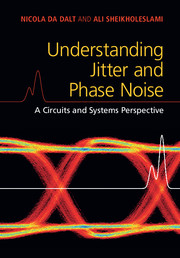Book contents
- Frontmatter
- Dedication
- Contents
- Preface
- Acknowledgments
- 1 Introduction to Jitter
- 2 Basics of Jitter
- 3 Jitter and Phase Noise
- 4 Jitter and Phase Noise in Circuits
- 5 Effects of Jitter in Synchronous Digital Circuits
- 6 Effects of Jitter on Data Converters
- 7 Effects of Jitter in Wireline Applications
- 8 Phase Noise in Wireless Applications
- 9 Advanced Concepts on Jitter and Phase Noise
- 10 Numerical Methods
- Appendix A Review of Random Variables and Processes
- Appendix B Matlab Code for Jitter Generation and Analysis
- Bibliography
- Index
3 - Jitter and Phase Noise
Published online by Cambridge University Press: 19 February 2018
- Frontmatter
- Dedication
- Contents
- Preface
- Acknowledgments
- 1 Introduction to Jitter
- 2 Basics of Jitter
- 3 Jitter and Phase Noise
- 4 Jitter and Phase Noise in Circuits
- 5 Effects of Jitter in Synchronous Digital Circuits
- 6 Effects of Jitter on Data Converters
- 7 Effects of Jitter in Wireline Applications
- 8 Phase Noise in Wireless Applications
- 9 Advanced Concepts on Jitter and Phase Noise
- 10 Numerical Methods
- Appendix A Review of Random Variables and Processes
- Appendix B Matlab Code for Jitter Generation and Analysis
- Bibliography
- Index
Summary
This chapter recalls the definitions and the insights introduced in Chapter 2 and elaborates on them in mathematical terms. It gives the reader a more complete understanding of the subject from a mathematical point of view, and provide tools and techniques to analyze quantitatively jitter issues in real systems. The mathematical foundations are reviewed in Appendix A.
In the main part of the chapter, the relation between phase noise and jitter is treated in depth. Examples of phase noise profiles are taken from those most common in practice, and their corresponding jitter is derived. The effect of spectral spurious tone on jitter is also considered and analyzed.
Basic Relationship Between Jitter and Excess Phase
In the following sections, the jitter concepts presented in the previous chapter will be related to the excess phase. Unless otherwise noted, we will assume a clock signal as described by Equation 2.2, and we refer the reader to Section 2.1 for a more generic discussion of the concept of an ideal clock and excess phase.
Excess Phase and Absolute Jitter in the Time Domain
The theory of phase noise is based on the assumption that the excess phase due to noise in electronic systems is a continuous-time process. This assumption is very well justified in practice. Indeed, even though the ultimate sources of noise – the charge carriers in the devices – are intrinsically quantized, noise events normally involve such a large number of particles and occur at such a high frequency that, for all practical purposes, even on a very small time scale, their effects can be considered continuous.
Jitter, on the other hand, can be defined and measured only when a clock transition is occurring, so it is intrinsically a discrete-time process. In this section we clarify the dependencies of the two processes.
If we assume a generic clock, represented by x(ω0t) periodic in T0 = 2π/ω0, where the term ω0t is the total phase of the signal, the time instants of the clock transitions can be defined as the time when the signal crosses a given constant threshold value with, e.g., positive slope. By properly choosing the origin of the time axis, the k-th clock transition occurs when the total phase is equal to 2πk.
- Type
- Chapter
- Information
- Understanding Jitter and Phase NoiseA Circuits and Systems Perspective, pp. 43 - 68Publisher: Cambridge University PressPrint publication year: 2018



